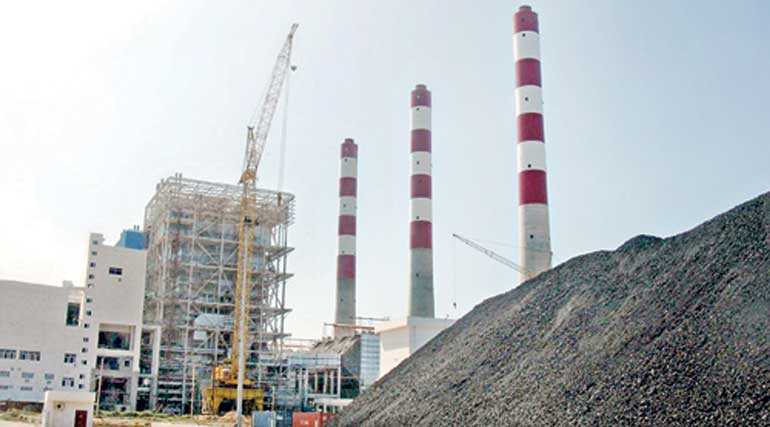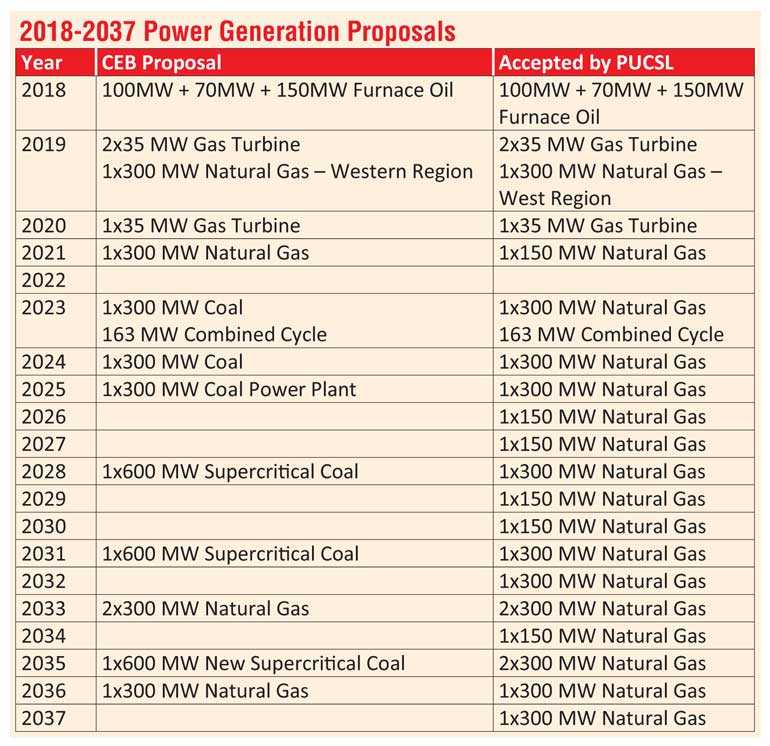Friday Dec 05, 2025
Friday Dec 05, 2025
Thursday, 7 June 2018 00:00 - - {{hitsCtrl.values.hits}}

The Norochcholai Coal Power Plant. CEBEU members claims they fight for lowest-cost power generation for the country’s consumers.
But how honest are they?
For the past few years, the Ceylon Electricity Board Engineers’ Union (CEBEU) and the Public Utilities Commission of Sri Lanka (PUCSL) have been at loggerheads over the approval of the CEB’s Long-Term Generation Plan. This has resulted in, since the Norochcholai power plant in 2015, no further electricity generating power plants materialising or being in the pipeline. Meanwhile, the country’s electricity demand grows by 200MW a year and the current shortage is around 500MW. The problem between the Engineers’ Union and the PUCSL seem to be insolvable and the President had to intervene.
Problem
Since 2013, CEB submitted a number of Long-Term Generation Expansion Plans (LTGEP) for the approval of PUCSL, but they were not acceptable to the Commission. The CEB proposal for 2015-2034 proposed power generation almost exclusively with coal. The Commission pointed out errors in computations and requested corrections and also requested inclusion of locally-available or imported natural gas-fired plants as an alternative to coal-fired plants.
As CEB refused to make amendments, the Commission rejected the CEB proposals and presented its own LTGEP 2015-2034. Ever since, the two parties have been making allegations at each other.
CEB presented its amended proposals for 2018-2037 in April 2017, including some LNG plants but majority still with coal; the proposal was modified by PUCSL. The summary of the CEB proposal and PUSCL modifications are given in the table. For simplicity hydro, wind and solar proposals are omitted.
CEB claims that its proposals are based on lowest cost, but PUCSL challenges computations are manipulated.
Environmental aspects of coal
Coal has been accused as the most polluting fuel. Main environmental concerns are:
Pollution, caused by emissions as sulphur dioxide, nitrogen oxides and mercury.
Greenhouse gases, emissions contributing to global warming.
Burning coal results fly-ash released into atmosphere (some captured in the chimney) and bottom ash (removed from the bottom of coal furnace).
Local experience is only small part of fly-ash is captured in the chimney. Bottom ash is stockpiled at the site (for how long?).
Villagers around Norochcholai complain of depositing coal dust in their houses and gardens from the ash mountain blown by the wind. Considering villagers complaints, Cabinet in January 2018 gave approval for the construction of a 15m high wind barrier around the coal yard and the ash yard at Puttalam at a cost of Rs. 723.7 million.
Indian and Chinese conduct
China and India are among the world’s largest coal producers and users. But in the past two years, India has retired around four gigawatts of coal power plants. India, faced with acute environmental challenges, is marching toward clean energy. In the year 2016-2017, it added more renewable energy than thermal power.
China continues to be the world’s leading coal producer and consumer. Last year the central government stopped or delayed work on about 150 planned coal-fired power plants, since last autumn it’s been directing northern cities to use natural gas replacing coal for heating homes.
PUSCL
The PUCSL was established under the Act No. 35 of 2002. It has a broad mandate to act both as a consumer protection authority, an advisory, inspection and policy formulation body and regulation of electrical power generation and distribution, water supply, petroleum resources and other public utilities in Sri Lanka. The Commission is expected to perform and discharge its powers reasonably with fairness, impartiality, in a transparent manner.
The Commission consists of five members appointed by the Minister with the concurrence of the Constitutional Council. The members of the Commission shall be persons with ability and integrity and have shown capacity in addressing problems relating to engineering, law, economics, business management or administration.
Commission Members have a five-year term. A member may be removed from office by the Minister after presenting the parliament and with majority support of the Members of Parliament (including those not present).
Meetings with the President
In February 2017, the President held a discussion on future plans for the development of power sector, attended by the Minister, Deputy and Secretary of Ministry of Power of Renewable Energy and CEB Chairman along with members of the CEBEU. The CEB Engineers’ Association expressed its views regarding challenges posed by interested groups against its plans on low-cost coal power plants.
It highlighted the importance of considering the opinions of experienced energy experts when implementing future plans and presented the long-term power generation plans of the CEB.
Following the Cabinet approval for the ‘Policy on Energy Mix of Electricity Generation in Sri Lanka,’ two weeks ago the PUCSL had requested the CEB to submit a new generation plan stressing that it was unethical to approve the original plan submitted by the CEB as it had already undergone amendments through several rounds of public consultation.
It was reported that on 21 May CEBEU has written to the President requesting him to remove the Director General of Public Utility Commission immediately from his post, for obstructing the approval of the electricity generation plan for 2018-2037.
To settle the dispute, the President called another meeting on 25 April with PUCSL, CEB, CEBEU, ministers and Power and Energy officials. It was reported when President inquired why PUCSL refused to approve CEB proposals which included multiple coal power plants, the Chairman of PUCSL had quoted a Cabinet Committee on Economic Management decision stating that “there will be no more coal power plants in the country as decided by HE the President”. The CCEM is headed by the Prime Minister.
The President had stated it was wrong for him to be quoted in CCEM minutes without his written commitment. President claimed he is not against hi-tech [Japanese], environment friendly coal power. The President has instructed PUCSL to approve the CEB’s long-term generation plan and the decision letter would be sent by the President’s Secretary to PUCSL Chairman. But at the end of the meeting President has stated a final decision would be made with the approval of the Cabinet.
In the latest bid to break the deadlock, the President convened another meeting on 28 April with ministry staff, PUCSL, CEB, CEBEU representatives and three top members of the Attorney General’s Department. The discussion focused on clarifying the duties and functions of the two institutions to negotiate an agreement between the two institutions.

Opinion of independent professionals
PUSCL had called a discussion with independent professionals on the CEB’s long-term power proposal 2018-2037.
During the discussion a professional had pointed out that CEB engineers, in a note to membership on 18 April, had claimed that the price of coal-based generation was Rs. 7.90 per kilowatt hour (kWh) when compared with Rs. 14.80 per kWh for gas-based power.
The gas-based generation cost (Rs. 14.80) is based on the tender rate for the proposed Kerawalapitiya LNG-powered electricity generation plant. The figure includes fuel, operational and finance costs also power plant owner’s profit. However, according to the latest bulk supply tariff submission made by the CEB to PUCSL for October-December 2017, the coal-based generation of Lakvijaya cost Rs. 14.53 to 14.74 per kWh.
CEB claims energy cost for Norochcholai is Rs. 8.87 per kWh. This figure refers only to basic energy cost, without fixed and variable overheads. In the PUCSL published actual generation costs for September 2017 based on CEB submissions, Lakvijaya cost Rs. 14.00 per kWh excluding debt-servicing, since the loan for the plant is the Treasury responsibility.
Integrity of CEB engineers
CEBEU members claims they fight for lowest-cost power generation for the country’s consumers. But how honest are they? They love coal-powered plants, from the inception of Norochcholai plant, entire coal supplies were from a single supplier from South Africa. When tenders are called, the Technical Evaluation Committee rejects other suppliers under various pretexts. When power plants got delayed, for over 20 years power shortages were replenished with high-cost purchased power from private power suppliers, a lucrative income for the engineers.
CEB is the highest paid employer in the State sector, even young engineers earning a basic salary of over Rs. 100,000 and senior engineers get over Rs. 200,000. Some time ago, their engineers in charge of projects demanded a monthly salary of Rs. 650,000, claiming overseas consultants are paid in millions. Engineers are paid overtime after 4:15, also numerous other allowances. CEB belongs to the exclusive category of the country as their PAYE payables are settled by the employer, as recently disclosed by the Auditors; a facility not available even to MPs.
CEBEU pressurises Government
CEBEU demands “Chairman of PUCSL be removed and staff members with an unblemished record and highest professional integrity be appointed to the posts of the PUCSL”. As such no present or past member of CEB can be appointed as a member of PUCSL.
Availability of local gas
The Indian firm Cairn engaged in oil exploration in M2 Block in Mannar Basin made two natural gas discoveries in 2011 named “Dorado” and “Barracuda”. However, when world’s oil prices crashed, Cairn was no longer interested in continuing forward.
On 30 May, the country signed an agreement with Eastern Echo Holdings Plc, a fully-owned subsidiary of the world’s largest US-based oilfield services company, Schlumberger, to conduct seismic surveys off the country’s east coast and Mannar Basin to evaluate prospects of oil and gas. The exploration will not cost Sri Lanka, but it will receive a copy of the report; Eastern Echo Holdings will sell the obtained data to Shell or Total, as allowed in the agreement.
In another related development, Sri Lanka is expected to call international tenders shortly to develop and further explorations the 2,924 sq.km M2 block in the Mannar Basin, where Cairn made two gas discoveries. According to Cairn’s data, 850 billion cubic feet of gas reserves are available in the M2 block. Although the PRDS received several unsolicited proposals from potential operators, the Cabinet-appointed Procurement Committee decided to call tenders. The natural gas extraction is expected to cost between $ 700 million to $ 1.5 billion, SL Government will purchase the entire output from Mannar M2 block.
Development of LNG power plants
The Board of Investment has given approval to China Machinery Engineering (which set up Norochcholai Plant) to set up a $500 million LNG plant near the Chinese-controlled Hambantota Port as a Government-to-Government project. The power would be basically for the projects in the Hambantota Industrial Zone, and excess energy would be sold to CEB. But CEB engineers have opposed the idea, claiming there is no provision in the Long-Term Generation Plan for a LNG plant in Hambantota.
LNG plants with India and Japan
When President Sirisena met Indian Prime Minister Narendra Modi in India, SL President conveyed the decision to cancel plans for the 500MW Indian-built coal-fired power plant at Sampur, Trincomalee and instead opt for a Liquefied Natural Gas (LNG) power plant.
Meanwhile, Japan had submitted an unsolicited proposal to build a 1,000MW high efficient clean coal power plant, initially limited to 500 MW, also at Trincomalee. President Sirisena during his visit to Japan had requested the Japanese Prime Minister to cancel this offer too and instead replace it with a natural gas power plant. Later, the Sri Lankan Government has signed Memoranda of Understanding with the Indian and Japanese Governments for building 500 MW each by the two countries.
Oil prices in the world market
World’s oil prices reached a peak of $ 140 a barrel in 2008, but the high prices soon collapsed when US companies started using fracking technology in mass scale. The US became the world’s biggest producer of petroleum overtaking Saudi Arabia. But the Saudis hit back, increasing production, forcing oil prices down which hit $ 43 in 2016. Lower prices had stopped oil exploration and development, now after years, oil prices have reached $ 80. New explorations and productions are commencing, but will take time to come on stream around 2023, hence the sudden interest in Sri Lanka’s proven gas resources.
Public response to coal power plants
The country’s first coal power plant was proposed in Trincomalee, but dropped due to prevailing war. In late 1980’s Mawella near the natural harbor capable of accommodating coal ships of 60,000DWT was proposed, but was abandoned under public protests. When Japanese consultants recommended Dungalpitiya in Negombo or Norochcholai in 1991, CEB selected more expensive Norochcholai, but protests delayed the project until 2008.
All large projects need environmental acceptance. Today, the public having experienced adverse environmental effects of coal, will not tolerate another coal power plant and attempting public consent would be extremely time-consuming.
Discussion
The President is facing a dilemma. He would prefer to satisfy CEBEU armed with trade union action, the easy way out. He is not a technical person and depends on interpretations submitted by his advisors. It is apparent that the President has not been properly briefed on all aspects of the dispute.
The President has listened more to the CEB union and their interpretation would be uppermost in his mind. Also, it appears the PUCSL representatives had not adequately presented their case. The President has called the three highest-level officers from the AG’s Department to advise him on the powers and responsibilities of CEB and the PUSCL.
CEB engineers are aware that local gas is on the horizon and when discoveries reach the market or are even near, consideration of coal-based power will disappear forever. This is the last opportunity to get additional coal-powered plants to be accepted and are trying their utmost. Coal plants have a life of over 25 years and retiring a coal-based plant or converting same to gas would be extremely expensive.
CEB engineers, being aware of their power to disrupt the country, demand strongly that coal-based plants be accepted, to the extent requiring President’s intervention, only because they receive heavy benefits from coal power.
The President has already consented to three LNG plants to India, Japan and China. The country is facing a power shortage and immediate power generation would be oil based as accepted by both parties. Establishment of a LNG based plant takes three years and a coal plant at least a year more. For a coal power plant, selection of the site and environment acceptance would consume many more years.
Even if the President accepts the CEB plan, three LNG plants already promised would have to be implemented. By around 2022, gas reserves from Mannar, with minimum of 850 billion cubic feet, would be available to the country. Does the President have an option?